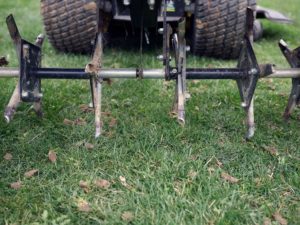
Fall is the best time to aerate cool-season grasses and prepare them for next spring.
Fall is the best time to address several lawn issues now that the heat of the summer is gone. During the summer, your lawn may have experienced drought, excess moisture, compaction, disease, or insect infestation. Any of these issues can impact the lawn throughout the following seasons. Fortunately, aeration can help alleviate some problems. Cool-season grasses like Kentucky Bluegrass and Tall Fescue are actively growing in the fall, so it’s a great time to aerate. After you aerate cool-season grasses, you can apply pre-emergent fertilizer to increase the health of your lawn. If you haven’t aerated your lawn in the past two years, consider the following ways this practice can positively impact your lawn.
Aeration Regenerates Root Systems
The primary reason to aerate cool-season grasses is to regenerate the root system. The roots supply the necessary oxygen, water, and nutrients your turf needs. Aeration opens up channels allowing oxygen directly to the roots. These channels also work as a funnel that allows water and nutrients to reach the roots, and the aerated space creates an undisturbed area for the roots to grow.
Aeration Oxygenates Microbes in the Root Zone
Oxygen is needed by the microbes that live in the root zone. These microbes not only deliver nutrients but eliminate waste that the turf secretes and reduces thatch buildup. Without the microbes, you would not have a survivable landscape.
It’s Easier to Change the Soil Chemistry
When you aerate cool-season grasses, it creates a more direct way to add nutrients that positively affect the soil chemistry. For instance, if a soil sample shows that the soil is low in calcium, aeration can help you introduce calcium directly into the soil. It’s more effective than applying it on top because it allows the nutrients to reach the root zone faster and reduces runoff of fertilizers.
Removes Thatch
Aeration is a great way to reduce excessive thatch from your lawn. Thatch often results from excess watering and high amounts of water-soluble nitrogen. If your thatch is greater than 3/4” more than one aeration session a year may be required.
Aeration Helps New Seed Take Root
When overseeding an existing lawn, core aeration helps create a good seedbed for that new seed. It can give the seedling uncompromised room to exist and take root.
Aeration can significantly benefit your lawn. If you want to give your yard a boost before winter sets in, aerate your lawn this fall.
Scientific Plant Service Is Your Go-To Source In Landscape Healthcare
Scientific Plant Service, located in Baltimore, is a privately owned corporation, chartered in Maryland in 1957 by Frank J. Burke. We started as a full-service Arborists specializing in the care of shade trees and ornamental shrubs, but today we are a Lawn Care company that is a huge part of the community. From aquatic environments and snow management to deer and mole control, SPS has services tailored specifically for your lawn and landscape.
We offer services in Maryland, Washington, DC, and Virginia, including: Harford, Baltimore, Carroll, Frederick, Howard, Anne Arundel, Montgomery, Prince Georges, Talbot, Queen Anne’s, Calvert counties in MD, as well as Loudoun County, Fairfax County, Arlington, Alexandria, and Falls Church in VA. For more information, contact us online, or call us at 410-321-0970. Be sure to follow us on Facebook, Twitter, LinkedIn, and Pinterest!

